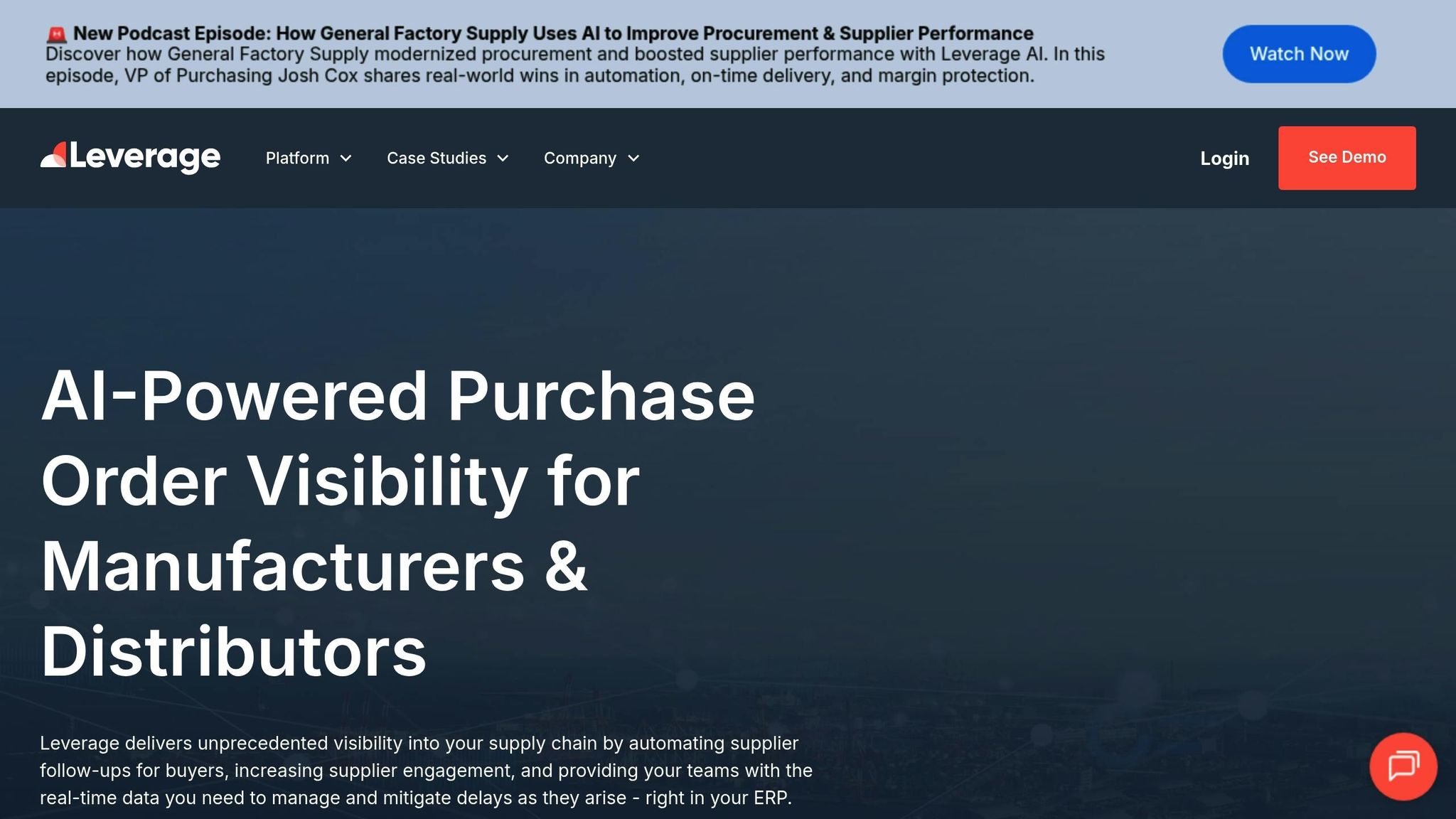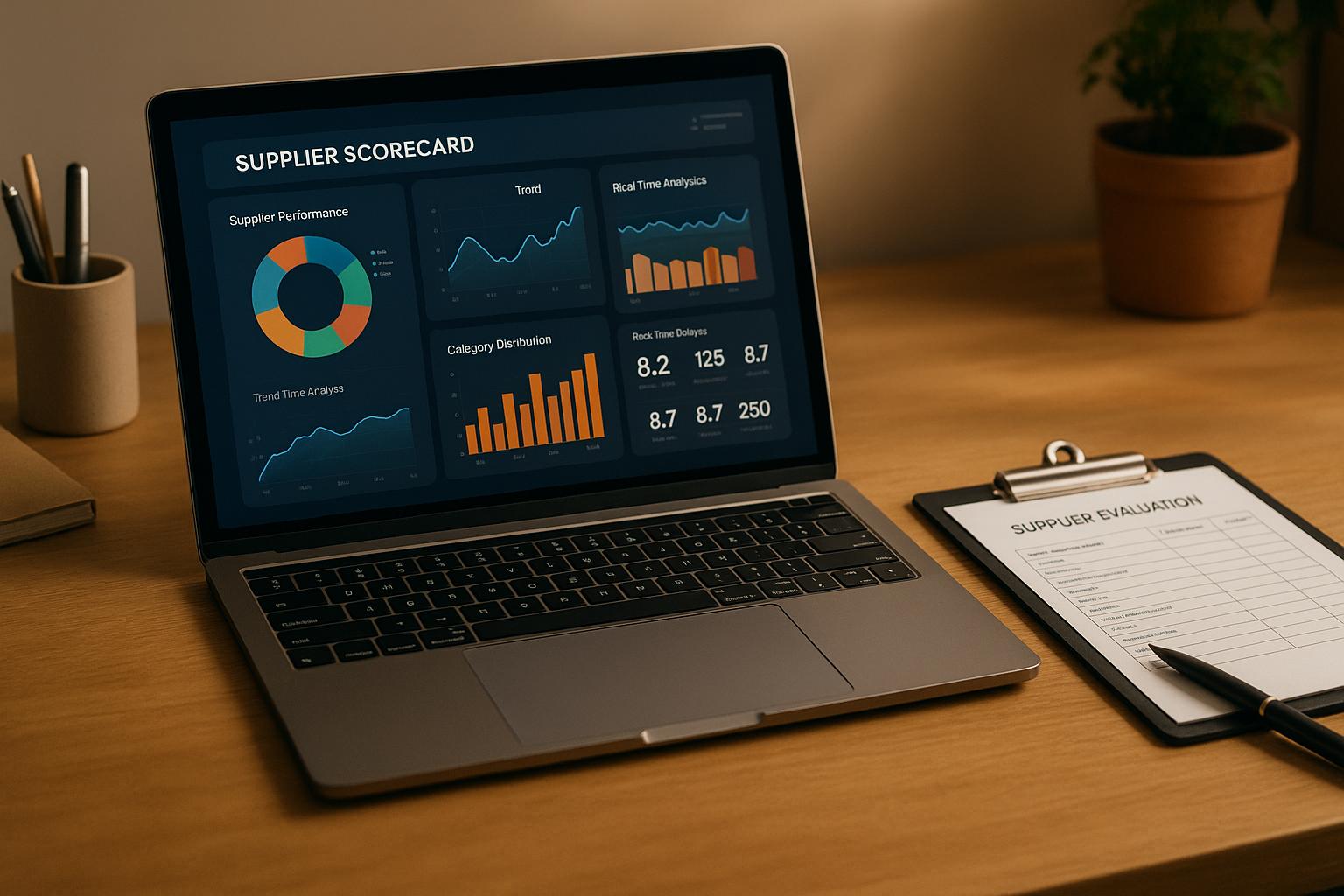Custom Dashboards for ERP-Integrated Supply Chains
.png?width=50&height=50&name=julie-miller-square%20(1).png)
Custom dashboards integrated with ERP systems simplify supply chain management by consolidating data into a single, user-friendly view. These dashboards let you monitor key metrics like inventory levels, supplier performance, and delivery schedules - without switching between systems. They save time, reduce errors, and improve decision-making.
AI-powered platforms like Leverage AI go a step further, combining automation with ERP integration. They provide real-time updates, automate tasks like supplier follow-ups, and deliver faster insights. While custom dashboards offer flexibility and control, they require significant development time and IT resources. Leverage AI, on the other hand, is quicker to implement but may require adapting workflows to its platform.
Key Takeaways:
- Custom Dashboards: Tailored to specific needs but resource-intensive to build and maintain.
- Leverage AI: Automates processes and offers instant insights but has limited customization.
- Best Fit: Large enterprises may prefer custom dashboards for complex needs, while mid-sized businesses benefit from AI solutions for faster results.
Ultimately, choosing between these options depends on your business size, goals, and available resources.
Using supply chain dashboards to steer your operations.
1. Custom ERP Dashboards
Custom ERP dashboards offer tailored views of performance data, designed to meet the needs of specific roles within an organization. These dashboards allow teams to focus on key performance indicators (KPIs) that align with their departmental objectives.
Take supply chain teams, for instance - they might track metrics like cycle time, perfect order rates, freight costs, inventory levels, supplier performance, and logistics efficiency. Users can also customize the dashboard layout, opting for charts, graphs, or tables to display the data that matters most to them. This adaptability ensures the dashboard remains relevant, even as operational needs evolve. It also creates a foundation to explore how these dashboards measure up against AI-driven options.
2. Leverage AI

Leverage AI combines automation with ERP integration to turn static dashboards into dynamic hubs that anticipate issues and enhance operational visibility. Below, we’ll explore how its integration, customization, and automation capabilities contribute to better supply chain performance.
Real-Time Data Integration
Leverage AI seamlessly connects with existing ERP systems, creating a centralized command center for supply chain management. This goes beyond simple data visualization - it actively tracks purchase orders, monitors supplier performance, and flags potential delays before they affect production schedules.
"By bringing together disparate systems in one centralized command and control platform, Leverage automatically calculates, surfaces, and visualizes your most important KPIs and OKRs so that you have all of your mission-critical reports at your fingertips."
Dashboards are automatically updated in real-time, eliminating the need for manual refreshes and ensuring insights are always up to date.
Customizability
Unlike many dashboard solutions that require complex configurations, Leverage AI simplifies customization through its integration features and analytics APIs. Businesses can adapt reporting KPIs and integrate the platform into their workflows without disrupting existing processes.
"Leverage AI provides some options for customization through integration and analytics APIs that enable access to real-time transaction data and supplier performance metrics. While core AI models focus on supply chain visibility and delay reduction, businesses can tailor reporting KPIs and embed the platform into their workflows. For extensive custom AI model adjustments, consulting with Leverage's integration specialists is advised."
The platform also includes advanced user management tools, allowing teams to control access to sensitive data and key metrics. This ensures secure collaboration while maintaining focus on critical objectives.
Automation Capabilities
Leverage AI takes efficiency a step further with its automation features. It automates supplier follow-ups, streamlines communication, and processes documents to update dashboards and send alerts - all without requiring manual input. This reduces the burden of data entry while keeping information accurate and actionable.
Business Impact
By addressing the need for unified supply chain insights, Leverage AI delivers measurable improvements. Real-time visibility and automation enhance overall supply chain performance. Supplier Performance Scorecards, for instance, offer actionable data for negotiations, reviews, and quotes, helping businesses stay on track with production schedules and meet customer commitments.
For organizations with unique needs, Leverage AI's integration specialists collaborate with IT teams to configure the platform to align with specific operational goals and system setups.
sbb-itb-b077dd9
Comparison of Strengths and Weaknesses
When comparing custom dashboards and AI-powered solutions, it's clear that each has its own set of trade-offs across key operational areas.
Real-time data integration is a critical area of distinction. Custom ERP dashboards excel in providing direct data access, ensuring accuracy and consistency. However, integrating data from multiple sources can be a complex and time-consuming process, often requiring extensive IT support. On the other hand, AI-powered solutions like Leverage AI simplify this by offering seamless ERP connectivity that centralizes supply chain data. That said, organizations may need to adjust their existing data structures to take full advantage of these capabilities.
Customizability is another point of divergence. Custom dashboards offer unparalleled flexibility, allowing businesses to tailor solutions to their exact needs. However, this level of customization comes with long development timelines, high maintenance costs, and the need for specialized expertise. In contrast, Leverage AI simplifies the process with API integrations and pre-built templates, enabling faster setup. While this approach reduces complexity, it may not fully meet unique business requirements without additional customization.
Automation capabilities highlight a major gap between these solutions. Custom ERP dashboards often require manual setup for automation, which can be resource-intensive and limit functionality to basic tasks like automated reporting or alerts. Leverage AI changes the game by offering built-in automation for tasks such as supplier follow-ups, document processing, and performance tracking. This minimizes manual effort, though it may necessitate some workflow adjustments to fit the platform's structure.
These technical differences translate directly into business impact, which varies based on an organization's priorities and resources. Custom ERP dashboards provide unmatched control and scalability but demand significant investment and lengthy implementation periods. In contrast, Leverage AI delivers a quicker return on investment (ROI) by offering immediate insights into supplier performance, making it an appealing option for businesses seeking fast, measurable improvements.
The table below compares the strengths and weaknesses of each approach:
| Criteria | Custom ERP Dashboards | Leverage AI |
|---|---|---|
| Real-Time Data Integration | Strengths: Direct ERP access, data consistency Weaknesses: Complex multi-source integration, high IT overhead |
Strengths: Seamless ERP connectivity, centralized data Weaknesses: May require data structure adaptation |
| Customizability | Strengths: Unlimited flexibility, complete control Weaknesses: Extended development, high maintenance |
Strengths: API integration, rapid deployment Weaknesses: Limited to platform capabilities |
| Automation Capabilities | Strengths: Full control over automation logic Weaknesses: Manual configuration required, limited out-of-box features |
Strengths: Built-in supplier automation, document processing Weaknesses: Must adapt to platform workflows |
| Business Impact | Strengths: Unlimited scalability, complete customization Weaknesses: High costs, extended implementation time |
Strengths: Fast ROI, immediate supplier insights Weaknesses: Platform-dependent functionality |
Ultimately, the decision between these two approaches hinges on factors like technical resources, organizational goals, and timelines. Companies with strong IT teams and a need for extensive customization may find custom ERP dashboards worth the investment. Meanwhile, organizations focused on speed and automation might gain more from AI-powered solutions like Leverage AI, which deliver immediate operational benefits. Carefully weighing these trade-offs is crucial for selecting a solution that enhances real-time supply chain visibility.
Conclusion
Deciding between custom ERP dashboards and AI-powered solutions like Leverage AI comes down to your organization's specific needs and strategic goals. Both options bring distinct operational strengths to the table.
Custom ERP dashboards are often the go-to for large enterprises with dedicated IT resources and intricate supply chain demands. These organizations can justify investing in tailored solutions that address complex regulatory challenges and manage extensive supplier networks.
On the other hand, AI-powered tools such as Leverage AI are a great fit for mid-sized manufacturers and distributors aiming to enhance efficiency without adding IT complexity. With features like instant supplier scorecards and automated document processing, these tools integrate seamlessly with ERP systems and provide quicker operational improvements.
In the U.S., where rising labor costs and frequent supply chain disruptions create pressure for faster results, AI-powered solutions often deliver a faster return on investment compared to the longer timelines required for custom dashboard development.
A hybrid approach can often strike the right balance. By implementing AI-powered solutions for immediate operational improvements while developing custom dashboards for future scalability, businesses can address short-term challenges and lay the groundwork for long-term growth. This dual strategy ensures both immediate results and a steady path toward sustainable success.
Ultimately, the key lies in selecting solutions that integrate smoothly with existing ERP systems and adapt to evolving supply chain needs. With the right tools in place, your organization will be well-positioned to navigate current challenges and achieve lasting success.
FAQs
What are the main advantages of using custom dashboards with ERP systems for supply chain management?
Integrating custom dashboards with ERP systems brings a host of advantages to supply chain management by delivering a real-time, centralized view of operations. This setup supports smarter decision-making, boosts efficiency, and provides better insight into key areas like inventory levels, order statuses, and logistics.
These dashboards also simplify resource management, monitor supplier performance, and improve communication across departments. By consolidating data in one place, businesses can react more quickly to disruptions, minimize delays, and strengthen their supply chain's ability to adapt. With these tools, companies can take a more proactive approach, ensuring greater transparency and smoother operations.
How does Leverage AI improve supply chain management compared to traditional ERP dashboards?
Leverage AI reshapes supply chain management by embedding AI-driven automation and real-time insights directly into ERP systems. Unlike traditional ERP dashboards that rely on static data, Leverage AI takes it a step further by automating supplier follow-ups, monitoring supplier performance, and delivering predictive insights to address potential delays before they escalate.
Key features like purchase order automation and advanced analytics simplify operations, improve supplier interactions, and offer a comprehensive, dynamic view of the entire supply chain. This empowers businesses to react swiftly to disruptions, boost efficiency, and make more informed decisions.
What should businesses consider when deciding between custom ERP dashboards and AI-powered tools like Leverage AI?
When weighing the options between custom ERP dashboards and AI-driven tools like Leverage AI, businesses need to consider their priorities in terms of customization, automation, and growth potential. Custom dashboards excel at offering personalized visualizations and centralized oversight, giving teams a clear snapshot of supply chain operations. That said, they often require ongoing manual updates and maintenance.
On the other hand, AI-powered solutions such as Leverage AI take things a step further. They don’t just visualize data - they automate workflows, deliver real-time analytics, and provide predictive insights. These features can streamline supply chain processes, cut down on delays, and improve supplier relationships. For companies aiming for dynamic, data-driven management with smooth ERP integration, AI tools often provide a more versatile and efficient solution.
.png?width=50&height=50&name=julie-miller-square%20(1).png)

